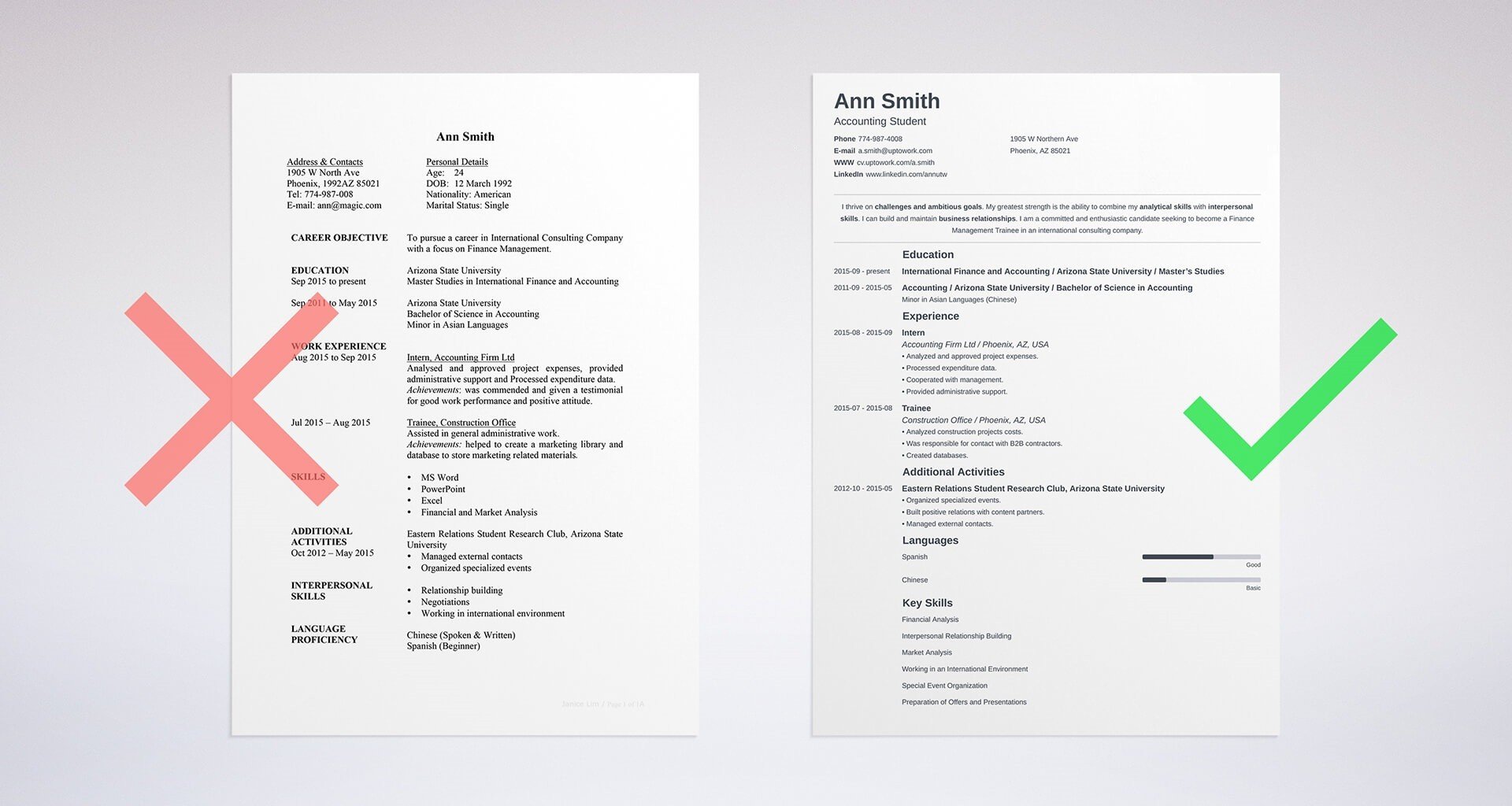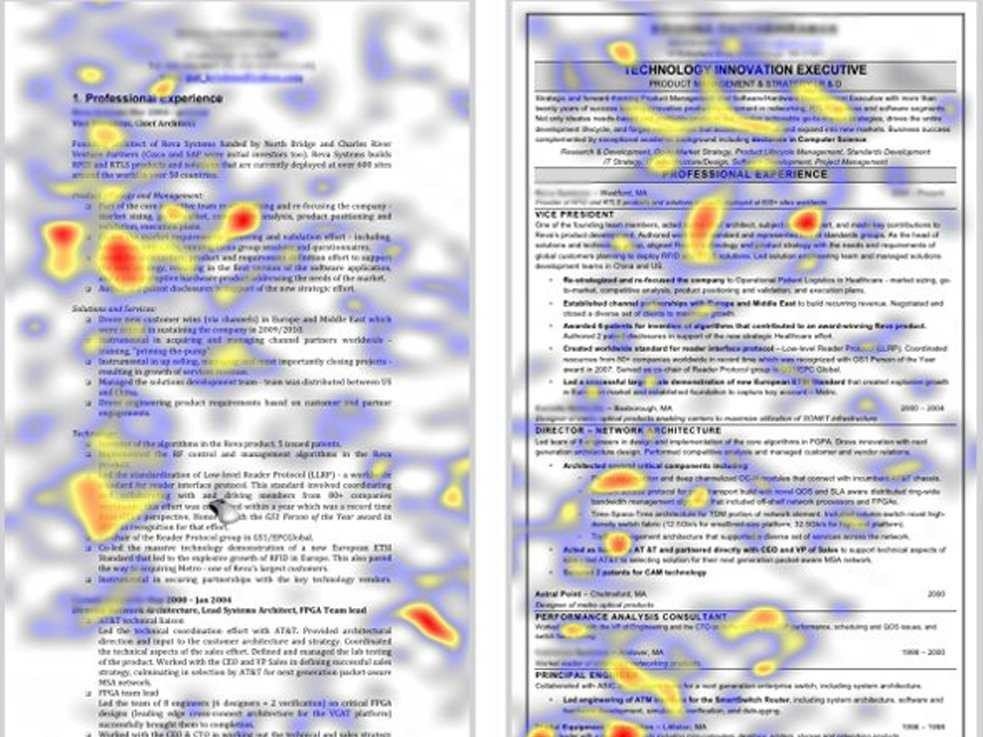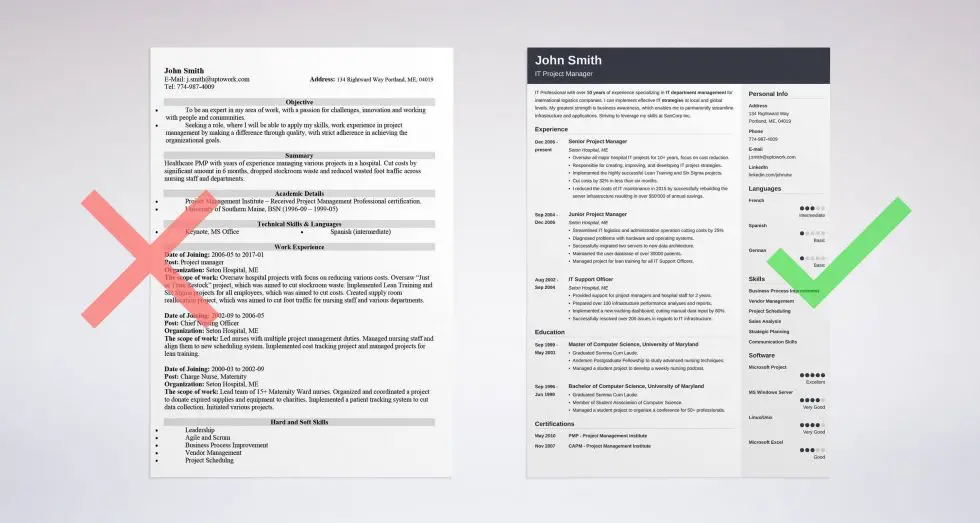We're about to give you dozens of our best resume tips, but first:
Maybe you’ve finished writing your resume, maybe you’re just starting.
Either way, you could probably use some quick resume pointers.
It’s easy to overlook things when you’re worried about finding a job. The best tips help you remember the smallest details of resume writing.
So, in this guide you'll find 42 of the best resume tips we could find for every step of the resume writing process.
For your convenience, we’ve divided the tips into two, five, and thirty-minute tips.
Next to each tip you will also see a star rating that ranks the tips in importance on a scale from one to five.
Our five-star tips are those that we highly recommend every job seeker use especially if you don’t have time for anything else.
Want to save time and have your resume ready in 5 minutes? Try our resume builder. It’s fast and easy to use. Plus, you’ll get ready-made content to add with one click. See 20+ resume templates and create your resume here.
These Resume Tips Will Take Two Minutes Tops
1. Create a professional email address.
Importance: ✸ ✸ ✸ ✸ ✸ ✸
Out of all of the resume building tips listed, this may seem too obvious.
But it’s worth mentioning because the use of an unprofessional email address will get you rejected 76% of the time.
So, if you haven’t already done so, ditch that email address you’ve been using since high school. Choose a professional email provider like Gmail or Outlook. Use your name.
Right:
john.smith@gmail.com
Wrong:
johnlikesgrapes@hotmail.com
2. Update your contact information.
Importance: ✸ ✸ ✸ ✸ ✸
After you change your email address, make sure the rest of your contact information on your resume is up to date.
You don’t want to miss an interview because you put the wrong phone number on your resume.
Also, exclude information like your birth date or marital status. You do not have to respond to questions about religion, race, or gender on an application. US employers cannot take these aspects into consideration when accessing you.
If you’re applying for a job out of state or country, also consider omitting your current address. That way a hiring manager won’t think you’re confused about the location of the job.
3. Set your font size to 10-12 points.
Importance: ✸ ✸ ✸ ✸ ✸
While choosing a font is important, making sure that it is the right size is paramount.
Keep your resume font size between 10-12 points so that a hiring manager can easily read it without squinting.
4. Use reverse-chronological order.
Importance: ✸ ✸ ✸ ✸ ✸
That means: start from your most recent job and work your way back.
For your experience section, put your current job first.
For your education section, put your highest degree first.
5. Align your content to the left to make it skimmable.
Importance: ✸ ✸ ✸ ✸
The first thing a hiring manager is going to do is skim your resume for relevant keywords from the job description.
Aligning your text to the left makes this easier for them to do.
6. Make strategic use of bold, caps, and italics.
Importance: ✸ ✸ ✸ ✸
Be consistent with your choices. If you’ve made one of your subheadings bold - make them all bold. Try not to overuse anything. The point is to make important information easier to find.
7. Choose an attractive and readable font.
Importance: ✸ ✸ ✸
You may think resume fonts are trivial in the larger scheme of things, but the right font is going to do a lot for your resume.
Right
Stick to fonts that sound like the names of hipster children:
- Verdana
- Arial
- Helvetica
Wrong
If you choose a font that is hard to read or childish, a hiring manager might toss your resume in the trash.
- Comic Sans
- Papyrus
- Curlz MT

Want to make sure your resume will hook every recruiter and get you that interview? Get our free checklist and learn what makes a job-winning resume: 46 Things You Need to Do Before You Send Your Resume
8. Only add jobs you’ve had in the past 10-15 years.
Importance: ✸ ✸ ✸
You do not need to list every job you’ve ever had on your resume. Make sure you go back on your resume no more than 10 or 15 years.
9. Give your sections simple subheadings.
Importance: ✸ ✸
Regardless of what layout you choose, make sure your resume sections are visible and easy to find.
You can do that by giving them simple subheadings.
For example:
Right
- Resume Summary
- Experience
- Education
- Skills
You’ll want to write simple subheadings for all sections. That way Applicant Tracking System (ATS) software can find them.
Wrong
- About Me
- Accreditations
- Professional Background and Work History
Pro Tip: Deciding what key skills to put on your resume is one of the biggest tasks that lie ahead of new resume writers. Make sure that they are easy to find and easy to skim as well.
10. Include URLs to social media profiles, personal websites, and your blog.
Importance: ✸ ✸
If you have a professional website or blog, include the URL in your contact section.
Add any relevant social media handles as well. For most professionals, that will include your LinkedIn URL and your Twitter handle.
Creative professionals could also consider adding relevant links to Instagram, Youtube, or Pinterest profiles.
Take an extra couple of minutes to make sure that your URLs are live and to hyperlink them in the text so they are accessible.
11. Choose a resume format that works for you.
Importance: ✸
What are the best formats for a resume? Well, that depends.
There are three types of resume formats:
Deciding what resume format to choose will be one of the first things you do.
Best
Most of you will opt for the reverse-chronological format. It’s the most common and you can play with the layout.
Worst
In almost every situation, the functional resume format is not a good choice because it kills your experience section. And even if you don’t have experience, that’s not the best way to handle it.
Pro Tip: Consider a format that gets your strongest information closest to the top of your resume where hiring managers will be sure to see it right away.
12. Consider using a professionally designed template.
Importance: ✸
Resume templates can save you a lot of time and effort. Imagine not having to fool around with margins in Word. Pick one out, and you’re ready to go.

13. Consider putting your education section first.
Importance: ✸
Once you’ve chosen a format, it’s a good idea to make a quick decision about the layout.
How do you build a strong resume?
After your contact information, start your resume with either a resume summary or a resume objective. More on that later.
But what should come next? Your education or your experience section?
If you’re a professional with tons of experience, your experience should come first.
But let’s say you’re a student and your educational background is your strongest selling point. In that case, consider putting your education section first.
14. Lose the phrase “References Available Upon Request.”
Importance: ✸
It is no longer necessary to place this phrase at the bottom of your resume, as hiring managers know that they can request your list of references.
Adding it only takes up valuable space that you could use for something else.
When making a resume in our builder, drag & drop bullet points, skills, and auto-fill the boring stuff. Spell check? Check. Start building your resume here.
When you’re done, Zety’s resume builder will score your resume and tell you exactly how to make it better.
Only Have Five Minutes? Here are the Best Resume Tips
15. Read the job description and then read it again.
Importance: ✸ ✸ ✸ ✸ ✸
Okay, reading the job description may sound like one of the most obvious resume-building tips ever.
Of course, you’ve read the job description. Right?
In fact, most people spend an average of 76 seconds reading a job description. And that’s why hiring managers find that 50% of applicants are unqualified for the job.
You’ve got to make sure you have the skills necessary for the job in the first place.
Right:
Read the job description. Make sure you’re qualified. Read it again. Mine it for keywords. Put it through a cloud generator. Target your resume. Take it on a date. Buy it Tiffany’s. Get married to it.
Because that job description is your best friend when it comes to building a great resume.
Wrong:
Seeing a job title that sounds right, sending your resume immediately.
Reading a job description is as close as you’re going to get to reading the recruiter’s mind.
Pro Tip: If you want to save time and find out how to write a resume for your profession, take a look at our guides and resume examples.
16. Make sure you’ve created margins.
Importance: ✸ ✸ ✸ ✸ ✸
Margins are important. That’s because resumes with text crammed edge to edge look messy and unprofessional.
Do you know where messy resumes go? You know.
If you do need a little more space, it’s okay to drop your bottom and top margins to 0.5” and your side margins to 0.75”. Anymore and you’re resume will suffer.
17. Balance your text and white space.
Importance: ✸ ✸ ✸ ✸ ✸
Balancing your text and white space is the same thing as adding margins. It makes your resume aesthetically pleasing and easy to read.
Do not sacrifice white space in the name of fitting everything onto one page. There are other ways.
18. Consider adding a coursework description.
Importance: ✸ ✸ ✸ ✸ ✸
This is one of the best resume tips for students. If you’re learning how to make a student resume, adding a coursework description is a good start.
Your education section is still your strongest asset. Listing or describing courses can show recruiters that you have skills related to the job.
Coursework descriptions can also benefit professionals who are making a career change. It shows that you’ve got relevant knowledge that goes beyond your past work experience.
19. Name your files properly.
Importance: ✸ ✸ ✸ ✸ ✸
This is a *pro* piece of resume advice: it is important to name your resume files properly.
Right:
John_Smith_Resume
Wrong:
Resume
Your resume could end up in an inbox with hundreds of other resumes.
And if they’re all named “resume,” then the chance of your resume standing out is slim to none.

20. Match your cover letter to your resume.
Importance: ✸ ✸ ✸ ✸ ✸
The two best cover letter tips are:
- Write a cover letter.
- Match the content of your cover letter to your resume.
Yes, you still need to write cover letters. And yes, they need to match your resume so that you’re telling the hiring manager one cohesive story.
If there was something you feel needs an explanation, write about it in your cover letter—see our great guide on how to write the perfect cover letter for a job application.
21. Draw attention to your promotions.
Importance: ✸ ✸ ✸ ✸
Make sure you’ve mentioned any promotions you’ve received.
You don’t have to list the name of the company more than once in the case of internal promotions.
Write the name of the company once. Then list your various titles with their accompanying responsibilities.
Example:
Company ABC
Marketing Manager
- Responsibilities.
Marketing Assistant
-
Responsibilities.
22. Cut the fluff in your experience section.
Importance: ✸ ✸ ✸
Is your resume is a bit longer than the ideal length for resumes (one to two pages)?
Then an easy way to cut fluff is to start by deleting bullet points in your experience section. Limit yourself to around six resume bullet points.
Right
List responsibilities that demonstrate the skills and experience you’ll need for your new job. Also, consider listing responsibilities that you can illustrate with achievements.
Wrong
Don’t list every responsibility you had at previous jobs.
23. Write explanations for large gaps in your career history.
Importance: ✸ ✸ ✸
Address significant gaps in your career history by writing brief explanations next to the jobs where the gaps occur.
Gaps can happen for all sorts of reasons.
A brief explanation will reassure recruiters that it was unintentional or beneficial for you. As in the case of a layoff or a break to have a child or go back to school.
24. Insert action verbs wherever possible.
Importance: ✸ ✸ ✸
Take a quick glance at your resume.
How many times have you used the phrase “responsible for?”
A million? It’s not uncommon.
The good news is that it only takes five minutes to replace that sad phrase with action-packed verbs.
Using action verbs and avoiding resume buzzwords is one of the best resume tips out there.
Remember, not all verbs are action verbs. Try to avoid weak verbs like “managed” or “communicated.”
Here are some alternatives:
Wrong: Managed
Right: Orchestrated
Wrong: Communicated
Right: Persuaded
25. Get rid of nonsensical jargon.
Importance: ✸ ✸ ✸
The person interviewing you may not be familiar with the technical jargon that goes with your territory.
Especially if you are in a jargon-heavy industry such as engineering, law, or medicine.
Try to use layman’s terms or simplified equivalents wherever possible.
Wrong: Dramatically cloudify viral innovation.
Right: Create digital backups for popular campaigns.

26. Run your job description and resume through a cloud generator.
Importance: ✸ ✸
Before you start writing, run your job description through a cloud generator. Which words are the most prominent?
You can use the words that appear as a content guide while writing your resume.
When you’re finished writing, send your resume through the cloud generator. Do the same words appear?
A cloud generator is a quick way to check that you’ve tailored your resume to meet the needs of the hiring manager.
27. Consider saving a copy of your resume as a PDF.
Importance: ✸ ✸
Saving your resume as a PDF is one of those resume tips that might not work for everyone.
Pros
The benefit of saving your resume as a PDF is that the formatting will not change when it’s opened.
Cons
The downside is that if a company is using ATS, a PDF might not be the best format for your resume.
Pro Tip: It’s often best to save your resume in a couple of file formats so you can send whatever is more suitable. It’s up to you to decide.
These Resume Tips Take 30 Minutes, But They’re So Worth It
28. Tailor your resume to the job description.
Importance: ✸ ✸ ✸ ✸ ✸
Tailoring your resume is probably the king of resume tips. If you do nothing else, tailor your resume to the job description.
You do that by identifying keyword skills in the offer and then add these skills throughout your resume. It sounds like a lot of work, but these keywords are what you should put on your resume above all else.
That’s because keywords are what hiring managers are looking for when they scan your resume.
29. Add achievements to your experience section.
Importance: ✸ ✸ ✸ ✸ ✸
If tailoring your resume to the job description is the king, adding achievements is the queen of resume tips.
Illustrating a skill or responsibility with an achievement puts you five steps ahead of candidates with the same skill set.
That’s because you’re showing what it looks like when you put your skills to work.
When adding achievements to your resume, use the X, Y, Z approach.
In situation X I did Y, which resulted in Z.
Right:
To generate user engagement, I performed multiple A/B tests, resulting in a 20% decrease in bounce rates and a 15% increase in sales conversions.
Wrong:
I won an employee of the year award.
30. Add numbers and details where possible.
Importance: ✸ ✸ ✸ ✸ ✸
Adding numbers and details to emphasize skills is by far one of the best resume tips you can follow. Anytime you can illustrate an achievement or skill with numbers or details - do it.
Right:
Increased sales by 12% over a 5 month period.
Wrong:
Responsible for sales.
Numbers draw the eye of the recruiter and details give them a tangible sense of what it looks like when you use a skill.
Maybe you increased sales, efficiency, or user engagement. Maybe you slashed costs. Whatever it is that you’ve achieved try to make it quantifiable.
31. Make good use of the top third of your resume.
Importance: ✸ ✸ ✸ ✸ ✸
Another very important tip for your resume. Think of the top third of your resume and “the penthouse.” It’s here that you want your best skills, experience, and achievements to appear.
Try to put the best stuff at the top.
Why?
Because when a recruiter scans your resume, they will focus on the top third of the document.

If they don’t find what they’re looking for in a few seconds of scanning, they will reject your resume as irrelevant. Read more with our guide on how to start writing a resume.
32. Include a resume summary or objective.
Importance: ✸ ✸ ✸ ✸ ✸
So, how do you get your best information in the top third of your resume?
Include a resume summary or a resume objective.
It’s three sentences of who you are, where you’re going, and why you’ll bring value to the company.
When considering how to write a resume summary or how to write a resume objective, keep in mind that the old school way is dead.
Wrong - What You Want
Dedicated Sales Manager seeking fulfilling work in children’s retail sector.
Right - What They Want
Dedicated Sales Manager with 5+ years of experience in the retail industry. Wishing to decrease returns for PeaPod Babywear by 15%.
33. Use a proofreading tool like Grammarly.
Importance: ✸ ✸ ✸ ✸ ✸
You cannot afford to have typos or grammar errors in your resume. The majority (61%) of recruiters will throw out a resume immediately if they see typos.
Microsoft Word or Google Docs will do a good job of detecting spelling errors, but the Grammarly app or Language Tool will catch grammar mistakes and typos.
You need to proofread your resume before sending your resume, and an app will help you catch things you can’t see.
34. Have a human proofread your resume.
Importance: ✸ ✸ ✸ ✸ ✸
Apps are great for catching mistakes, but another human being is priceless.
Grab whoever you can find with the patience to read through your resume.
They can also give you feedback about your tone and how you’re selling yourself.
35. Write a thank-you email.
Importance: ✸ ✸ ✸ ✸ ✸
Knowing how to write a thank you email after an interview is priceless.
It’s not always enough to write a great resume and ace an interview. The show isn’t over until you’ve also written a thoughtful thank-you email.
36. Clean up your online presence.
Importance: ✸ ✸ ✸ ✸ ✸
When you’re just learning how to create a resume, you may forget that hiring managers also search for you online.
Be sure to optimize your LinkedIn profile so that it resonates with your resume.
Make sure that you’ve cleaned up “public” information on your Facebook and Twitter accounts. Change your Facebook privacy settings to “Friends” to keep future posts from becoming public.
And do a quick sweep to make sure nothing else unsavory is lurking out there on the Internet. Enter your name into Google and see what turns up in the results.
You can ask Google to remove sensitive or sexual content from the web.
37. Create a professional persona for yourself.
Importance: ✸ ✸ ✸ ✸
A professional persona is a two or three-word description of yourself that should stick in the head of the recruiter when your name doesn’t.
It’s like when you try to describe someone from last night’s party.
Remember the girl who graduated from Harvard and talked about goat cheese for an hour?
It’s like that except less goat cheese.

38. Reinforce your professional titles by showing career progression.
Importance: ✸ ✸ ✸ ✸
Putting a bunch of flashy job titles on your resume isn’t the most impressive thing you can do believe it or not.
What is impressive is the telling the story of your career progression.
See, you can be a social media manager for your cousin’s pizza place without any prior experience.
But when you can show that you progressed to that position through hard work, that’s impressive.
The trick is trying to make each past role reinforce your place in the next one.
Example:
Marketing Manager
- Manage a team of 10+ employees.
- Prepare annual marketing plans.
Marketing Specialist
- Planned and implemented promotional campaigns.
- Cooperated with interactive agencies.
Marketing Intern
- Conducted market research.
- Assisted during promotional campaigns.
39. Consider adding a Hobbies and Interest section to your resume.
Importance: ✸ ✸ ✸
If you have space, hobbies and interests can be great additions to your resume.
That’s because companies are beginning to emphasize work culture. Which makes finding a candidate with a fitting personality increasingly important.
Just be sure to research your company. Choosing hobbies and interests that match the company’s culture is a good strategy.
Right:
Work Culture: Corporation participates in charity marathons.
Hobbies and Interests: Volunteer Work and Athletics
Wrong:
Religious, political, or sexual hobbies.
If the person reading your resume has an opposite opinion, it could hurt your chances of getting an interview.
40. Trim any unnecessary fat from your resume.
Importance: ✸ ✸ ✸
Having problems keeping the length of your resume in check?
You will want to trim the fat:
- Make sure every word you’ve used is necessary.
- Keep your bullet points to six at most.
- Trim your resume summary or your skills section without killing the value.
- And kill any extra sections that aren’t mandatory.
41. Try to find the personal email address of the hiring manager.
Importance: ✸ ✸ ✸
You can always attach your resume to a generic email and send it to a generic inbox.
Or you can attach your resume to a personalized email and send it to your hiring manager.
Some hiring managers may not appreciate receiving unsolicited resumes.
At the same time, if you know how to send an email to a hiring manager you know that you aren’t sending it unannounced.
Right:
You establish contact via a referral or LinkedIn before sending your resume.
Wrong:
Sending a cold-call email to an unknown hiring manager.
42. Track your resume.
Importance: ✸ ✸
Instead of waiting around for a phone call, track your email so that you know the moment a hiring manager opens it.
You can use a free tool like Mixmax to see if a hiring manager has read your resume. That gives you a better idea of when to send follow-up or thank you emails.
43. Do not lie on your resume.
Importance: ✸ ✸ ✸ ✸ ✸
No need to explain. You will get caught lying on your resume: in the interview or after you've been hired.
It will cost you your job, career, or a costly lawsuit.
44. Do not worry about making your resume one page long.
Importance: ✸ ✸ ✸ ✸
You've heard it before: a resume has a perfect length. And that's one page. However, most employers expect experienced candidates to submit resumes at least two pages long.
45. Don't try to impress employers with fancy paper.
Importance: ✸ ✸ ✸ ✸ ✸
Need to print your resume on paper? See the link to learn what kind of paper works best (and doesn't make you look the fool.)
Check out our resume dos and don'ts to avoid more mistakes!

Key Takeaway
It can be easy to forget small details when you’re trying to figure out how to write a great resume. But if you follow these resume tips and tricks you can rest assured that you’re on the right track.
This article first appeared in Zety.


